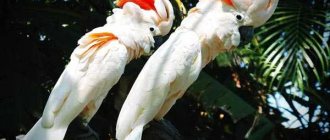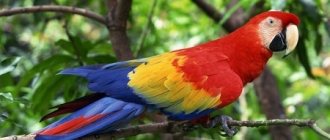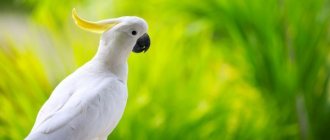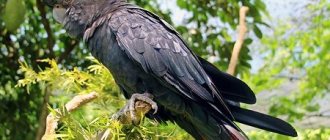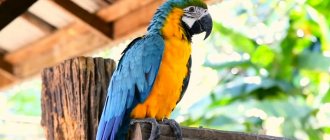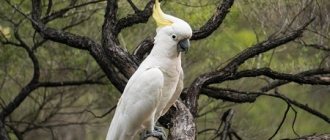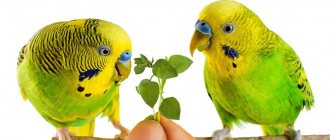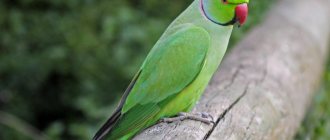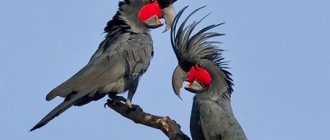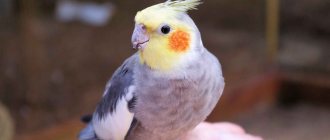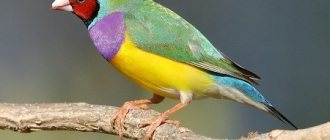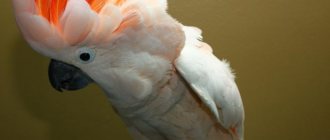The pink cockatoo is a small Australian parrot with advanced linguistic abilities and an awkward, hobbling gait. In its homeland it is considered perhaps the main enemy of local farmers, and in Europe it is in high demand among lovers of exotic birds.
Let's find out what the pink cockatoo looks like, what it eats and what kind of life it leads.
Appearance and dimensions
Unlike other birds from this family, the pink cockatoo cannot boast of large dimensions. The average weight of a parrot is 350 g, and its body length reaches 25-30 cm.
The upper part of the bird's body, including the back, wings and tail, is colored smoky gray. The head, neck, chest and abdomen are pink-red. The parrot's forehead is covered with lighter feathers.
The outer part of the scallop is red-pink, the inner part is pale pink. The paws are dark gray, the beak is ivory. The small, light-colored eyes have reddish, blue or pink rings around them.
On a note. The gender of pink cockatoos can be determined by the shade of the iris. In males it is dark brown or black, in females it is pink, light orange or red.
Description
These are fairly large and medium-sized parrots, ranging from 30 to 60 cm in length, weighing 300–1200 g. The beak is strongly curved, long and very massive. The external structure of the beak has characteristic features that make it possible to distinguish cockatoos from other parrots: the mandible is always wider than the upper beak in its widest part; for this reason, the edges of the mandible overlap the narrower mandible, like a scoop. Another distinctive feature of the bird is the presence of a crest - elongated feathers on the crown and back of the head.
An excited cockatoo willingly demonstrates it, spreading it like a fan and thereby attracting the attention of other members of the flock. The color of the crest differs from the general color of the plumage and may consist of white, black, pink or yellow feathers
Green color is completely absent. Males and females are colored the same, but females are slightly smaller. The tail is short, straight-cut or slightly rounded. This beak arrangement is typical only for cockatoos. With their beak they are able to break not only the wooden bars of the cage, but also those made of soft wire. In nature, the hard shells of various nuts are easily broken down. The fleshy tongue at the end is covered with a black cornea, with a hollow, which the parrot uses like a spoon. The cere in some species is naked, in others it is feathered. They fly tolerably well and climb trees excellently. Most of these parrots move very deftly on the ground. They can also sometimes live in aquatic environments.
Character and behavior
The pink cockatoo has a friendly and sociable disposition. The cheerful and fearless parrot loves to play and easily makes contact with people. He is easily tamed and suffers from lack of attention.
When alone, the pink cockatoo begins to scream or pluck its feathers. Therefore, if a person is absent from the house for a long time, you need to leave the radio on for the parrot so that he does not get bored.
Interesting! The crest is not only a decoration for the pink cockatoo, but also a kind of indicator - from it you can understand what mood the parrot is in. If he is peaceful, then the comb is in the folded position. If a bird is frightened, excited, interested in something, or worried about an invasion of its territory, its crest rises.
Habitat and lifestyle
Pink cockatoos inhabit Tasmania, all of Australia and neighboring islands. These birds can be seen in forests, savannas, mountains, meadows and parks.
Typically, pink cockatoos group in small flocks of about 20 birds. In the heat, parrots hide in the crowns of trees, and when coolness falls on the ground, they fly to watering places. In the rain, birds like to hang upside down with their wings open and splash under the water jets.
Interesting! Pink cockatoos fly at speeds of up to 70 km/h. But parrots move on the ground with an awkward, hobbling gait. Because of their stupid way of moving, the natives call pink cockatoos “gala,” which translated from the local dialect means “boob” or “clown.”
These parrots prefer to mate for life. But if one of the birds dies, the other can find a replacement.
To interest the female, the male spreads his wings, raises his crest and begins to shake his head funny.
An established pair of pink cockatoos builds a nest in rock gorges or in hollows at a height of 4-20 m from the ground. Some time after mating, the female lays a clutch of 2-5 medium-sized white eggs. The incubation process involves both birds and lasts about 30 days. Hatched pink cockatoo chicks are under the care of their parents until they are 3 months old.
Reproduction
To breed pink cockatoos, you can build a fabric nest for them and put sawdust or soft materials on the bottom of the house inside the cage. After courtship, the parrots will decorate the place for hatching eggs with down and feathers, and move the sawdust independently at their discretion.
Typically, a clutch contains from 2 to 5 eggs, which are incubated alternately by both partners. At the same time, only the female remains in the nest at night. The chicks hatch after a month. The cubs acquire adult plumage 30 days after the end of the incubation period. In the wild, cockatoos gather in flocks, so the chicks stick together even after they leave the nest.
Pink Cockatoo (Part Two). All About Pets
Features of keeping at home
Due to their attractive appearance, cheerful disposition and ability to copy human speech, pink cockatoos are often bought as decorative pets. But since these exotic birds are much larger than the usual budgies or canaries, they need special living conditions.
For keeping pink cockatoos, light, well-ventilated and warm rooms with a durable metal cage measuring 120x90x90 cm are suitable. The floor is covered with sawdust, paper or sand.
And inside the parrot cage they place:
- bathing tub with water;
- drinking bowl (screwed to the rods);
- several feeders for different types of food;
- perches at different heights;
- mineral stone or twigs for grinding down the beak;
- toys (rattles, bells, rings, ropes and ladders).
To maintain order, food and water bowls are rinsed daily. The cage is cleaned and the bedding is replaced every other day. And once a week the parrot’s home is treated with a weak solution of potassium permanganate.
A tamed pink cockatoo must be provided with adequate nutrition. Half of a parrot's daily diet should consist of a mixture of grains. Additionally, fresh greens, powdered shells, seeds, chalk, pumpkin, limestone, bell peppers, corn, carrots, bananas and grapefruits are introduced into the bird’s diet.
Important! You should not feed your parrot nuts and sunflower seeds too often. These foods are high in fat and can cause digestive problems in birds.
Pink cockatoos are interesting parrots with beautiful gray-pink plumage and a cheerful, playful disposition. Birds easily get used to being handled and, subject to certain conditions, can live in captivity.
Breeding
Cockatoos have a rather difficult time getting along with each other, so it is best to purchase a pair of young birds of different sexes and keep them together until they mature; in this case, the formation of a strong couple is most likely. For the same reasons, it is quite difficult to find a mate for a cockatoo that has lost its partner.
V.A. Grinev describes the amazing life of free-living large yellow-crested cockatoos in Askania-Nova: “In the Askania-Nova reserve at the beginning of this century, a pair of large yellow-crested cockatoos, in conditions of absolute freedom, bred 2 chicks for 2 years in a row, and these 6 large white birds flew for several years feed on fields of wheat, barley, oats, etc. Like pigeons, they stayed in a flock all the time.” There is evidence of the breeding of this species under artificial conditions by S.K. Gulbe and A.P. Gileva.
This happened at the Riga Zoo in the period 1983-1985. A pair of birds were placed in a room consisting of two adjacent enclosures - an external one and an insulated internal one. These authors consider the presence of high air humidity in the interior, not lower than 80%, to be an important condition for the reproduction of parrots. Indeed, in dry rooms, the shell shells dry out, their gas permeability decreases, as a result of which the embryos die. The nest house was small (38x34x34 cm), made of thick multilayer plywood, with a 10x12 cm entrance. At the bottom of the house there was a layer of sawdust. Over the course of three nesting seasons, the birds laid eggs in November, August and July. Each clutch contained 2 eggs. In the first clutch, one egg was unfertilized, and in the second, the embryo died. But the second and third nestings ended successfully: each time the birds raised two chicks.
Proper nutrition
The authors also consider proper feeding of cockatoos to be an important factor in successful bird breeding. The birds were given soft and grain feed; the diet per bird consisted of the following components: boiled egg (1/4 part), rice porridge (15 g), boiled meat (20) and corn (15), wheat bread (15), sweet fruits (50), vegetables (30), berries (50), greens and milk (30 each), cottage cheese (10), dried fruits and compote (40 each), walnuts (20), sunflower (10), oats (20), wheat (15 ), corn (20), sprouted grain (10 g). Calcium, phosphorus and microelements, vitamins A, D3, E were always added to the food. Lump salt, shells, chalk and gravel were constantly present in the enclosure. Assessing this rich diet, it should be recognized that many breeders do not give pure salt to their birds, believing that it can harm them. You can also recommend giving parrots twig food. They not only serve as a source of additional vitamins, but also give the pet something to do, distracting him from the boring sitting on his little seat.
Cockatoo cage
Cockatoos have a very powerful beak and this must be taken into account when purchasing a cage. The cage should be large and spacious so that the parrot can flap its wings freely. The cage must be closed with a large, reliable lock; the cockatoo is very smart and can open simple locks in no time. The rods are very strong and thick. Dimensions: width – 80 cm: height – 90 cm; length – 80 cm; The cage should contain branches for gnawing and calcium for grinding down the beak. The cage should be located in a well-lit room and closed from drafts.
Cockatoo feeding
Proper feeding is of great importance for proper development and growth. The main diet for cockatoos is grain mixtures. Try to diversify your cockatoo's diet. The grain feed should consist of millet of various varieties, buckwheat, canary seed, some nuts, seeds and hemp.
- Fruits for the parrot. Strawberries, raspberries, pears, rose hips and apples are suitable for cockatoos. Not all parrots eat fruit right away - they need to be taught. It is better to cut large fruits so that the parrot can take a piece in its paw. Leftover fruit must be removed every day.
- Vegetables for the parrot. Parrots can be given carrots, cucumbers, eggplants and celery. Dandelion roots will work well. Green beans and pea pods, red beets, fennel and other vegetables.
- Animal food. Protein plays a big role for cockatoos. It is better to feed boiled chicken meat. In addition, cockatoos can be given yogurt, cottage cheese, and cheese.
Cockatoos may refuse any food except sunflower seeds, but it is necessary to accustom the birds to a variety of foods. This is easier to do when transferring the chicks to an adult diet. Limit your pink cockatoo's fat intake to reduce the risk of tumors.
Toys
Cockatoos need visual variety and intellectual stimulation. Toys will help satisfy the needs of these curious beaks and give them the opportunity to independently entertain themselves and develop, but they should not be meaningless. The “right” toys for cockatoos are those that make you want to take them apart (pyramids, puzzles), sort them out, untie knots, toss them (rings, balls) and make sounds (bells, rattles). Toys must be made from safe materials: wood, coconut or sisal fiber, or hard plastic.
Diseases
Self-plucking is one of the most common, painful and unpleasant diseases of cockatoos, which can be caused by:
- In most cases, an unbalanced and monotonous diet, in which several specific components predominate (for example, sunflower seeds), this leads to metabolic disorders in the body and, as a result, to self-plucking.
- Treating a parrot with ointment. A feather smeared with a greasy substance loses its properties, so the bird tries to clean it and if it fails, it simply pulls it out. Accordingly, if the ointment is applied to a large area of the plumage, the parrot will not calm down until the entire affected area is eliminated.
- Environmental factors: room temperature too high or too low, humidity, close proximity to a strong light source, or inability to swim.
- If the cockatoo does not have a mate: boredom and lack of communication.
- External parasites: lice eaters, pereaters, scabies mites, fungi and others. The real probability of a “domestic” parrot becoming infected with ectoparasites is minimal, because indoor birds have no contact with wild fauna.
Self-plucking is dangerous because it can turn into a habit that not only brings pain to the bird and deprives it of its plumage, but is also harmful to health. The feather follicle often bleeds, this bothers the bird and excites others who are in the same cage; sometimes self-plucking leads to cannibalism.
It is almost impossible to establish the cause and independently prescribe effective treatment at home. A bird with self-plucking syndrome needs qualified examination and treatment.
